Dear Friends,
As difficult scenes of violence unfold in holy places venerated by both Muslims and Jews alike, we must not allow ultra-nationalist elements to harness religiosity as a tool to sow further divisiveness. The most enduring and sensitive issues of the conflict can only be settled through a negotiated political solution, and we must work towards maintaining a diplomatic horizon to that end. Click on the headlines below for our analysis on how developments this month impacted the feasibility of the two-state solution.
|
|
|
|
These events increased the Two State Index by +1.5% in April (up 0.07 points from 5.56 to 5.63)
|
|
|
|
|
To learn about the Geneva Initiative's TSI, visit our website.
|
|
|
|
Violence flares across West Bank, East Jerusalem Amid Holiday Clashes and Spike in Terror Attacks
Violence spiraled this month as the convergence of Ramadan, Passover, and Easter heightened sensitivities at flashpoints across the West Bank and East Jerusalem. In Nablus, Palestinian mobs desecrated Joseph’s Tomb on two occasions, clashing with Israeli forces who entered the flashpoint site in Area A to secure restoration work on the shrine. Meanwhile, Israeli forces entered Al-Aqsa Mosque on the Temple Mount/Haram al-Sharif compound on numerous occasions this month sparking violent clashes.
The most intense violence came on April 15th, as Friday Ramadan prayers converged with the beginning of the Passover holiday and Palestinians barricaded in the mosque hurled rocks at Jewish worshippers at the Western Wall below. Over 150 Palestinians were wounded and some 400 were arrested in the rioting that ensued, and the optics of heavily armed Israeli forces clashing with Palestinians as they entered the third-holiest site for Muslims sparked an intense international backlash.
Footage from the clashes has drawn criticism of Israeli police’s excessive use of force. But Israel insists that its forces have acted responsibly and with restraint, entering the flashpoint compound to quash riots only after exhausting all other means including intensive dialogue with the Jordanian-administered Waqf. In a special UN Security Council briefing, UN Special Coordinator for the Middle East Peace Process Tor Wennesland appeared to adopt the Israeli account of how clashes unfolded, testifying that violence erupted after Palestinians threw stones, fireworks and other heavy objects – countering Palestinian claims that Israeli forces entered unprovoked.
|
|
|
|
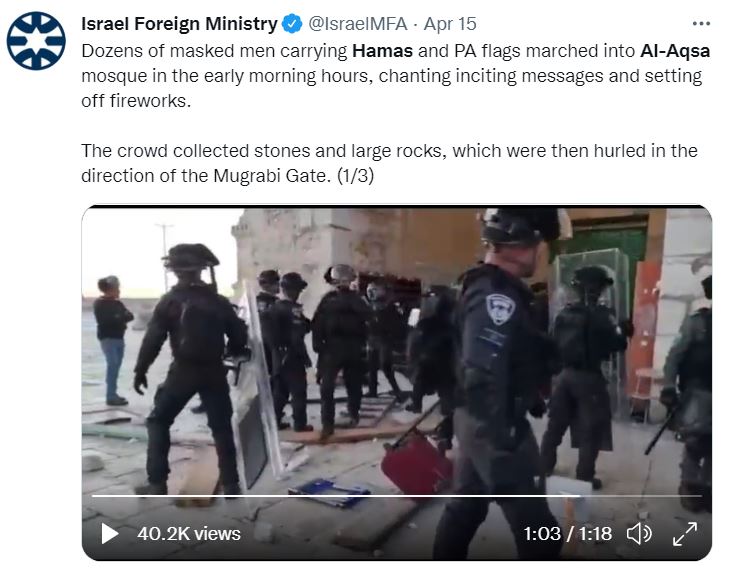
Over the last two years, the convergence of Ramadan and Passover has tested the will of Israeli, Palestinian, and regional leaders to work together to avoid an annual recurrence of such events. Next year will be no different. The Geneva Initiative views the current crisis as an opportunity to take concrete steps that go beyond technical security arrangements with a view to the broader picture, by strengthening the roles of the PA and Jordan and limiting the influence of extremists on both sides who would seek to capitalize on religious sensitivities to inflame nationalistic sentiment and drive opposition to the two-state solution.
The TSI’s reversed-scale Palestinian Attacks (West Bank) parameter increases from 8 to 8.3 this month, reflecting that an increase in violence underscores the necessity of reaching a negotiated two-state solution to the conflict. The Israeli public discourse parameter also increases from 7 to 7.5 this month, while the Palestinian Public Discourse parameter remains unchanged at 4.
|
|
|
|
World’s Eyes Turn to Israeli-Palestinian Violence at Jerusalem Holy Sites, Putting Two-State Solution Back on Diplomatic Agenda
Intensifying violence at East Jerusalem holy sites re-focused the world’s attention on the Israeli-Palestinian conflict this month as global leaders pressed to stabilize the situation and avoid a full-scale escalation. Clashes at the holy site last year helped spark an 11-day war with Hamas, and with tensions already flaring amid a wave of recent attacks, US Secretary of State Antony Blinken held separate calls with PA President Abbas and Israeli FM Lapid urging both sides to exercise "restraint". The US also dispatched Acting Assistant Secretary of State for Near Eastern Affairs Yael Lambert and Deputy Assistant Secretary of State for Israel and Palestinian Affairs Hady Amr on an emergency visit to Israel, Jordan and the West Bank in a bid to restore calm to the region.
Amid the tensions, US President Joe Biden accepted an invitation from Israeli PM Naftali Bennett to visit Israel. While a parallel visit to meet Abbas was not announced, it would be an expected and important gesture of Washington’s support for the PA and commitment to the two-state solution. “The crisis in Jerusalem put the Israeli-Palestinian conflict back on the US political agenda, but also showed that the Israeli and American approach to ‘shrink the conflict’ is a big mistake in terms of US foreign policy. The crisis in Jerusalem and Al-Aqsa will not be solved without a political solution,” analyst Mohammed Daraghmeh says.
|
|
|
|
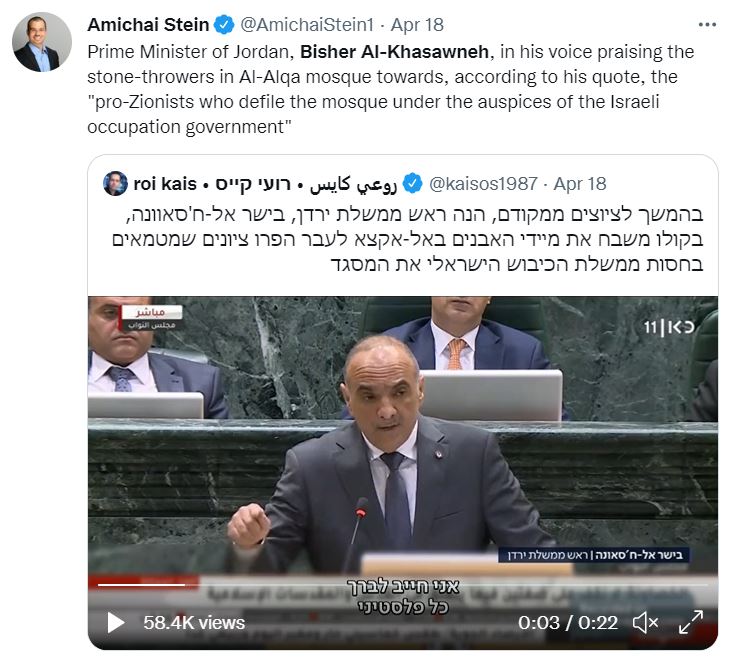
The violence on Temple Mount/Haram al Sharif draws the world’s attention back to the unsustainable situation in the region. Palestinian officials in Ramallah have been working hard since February to redirect the international attention back toward the Israeli-Palestinian conflict, amid concern that Israel would seek to take advantage of preoccupation with Ukraine and Iran to impose new facts on the ground. But despite sharp political rhetoric, Israel has largely succeeded in demonstrating a measured response to recent violence, and a clear interest in maintaining recent progress made in engaging with and strengthening the PA until now.
The TSI’s International Public Opinion parameter rises from 5 to 6 amid a rise in rhetoric in support of a two-state solution in light of the high-profile nature of recent violence in Jerusalem. All relevant International Actors parameters remain unchanged, with both the US and Arab world maintaining a high level of engagement on Israeli-Palestinian issues that began last month.
|
|
|
|
Status Quo of Jerusalem Holy Sites in Question Amid Record Number of Jewish Visitors to Temple Mount/Haram al-Sharif During Passover:
|
|
|
|
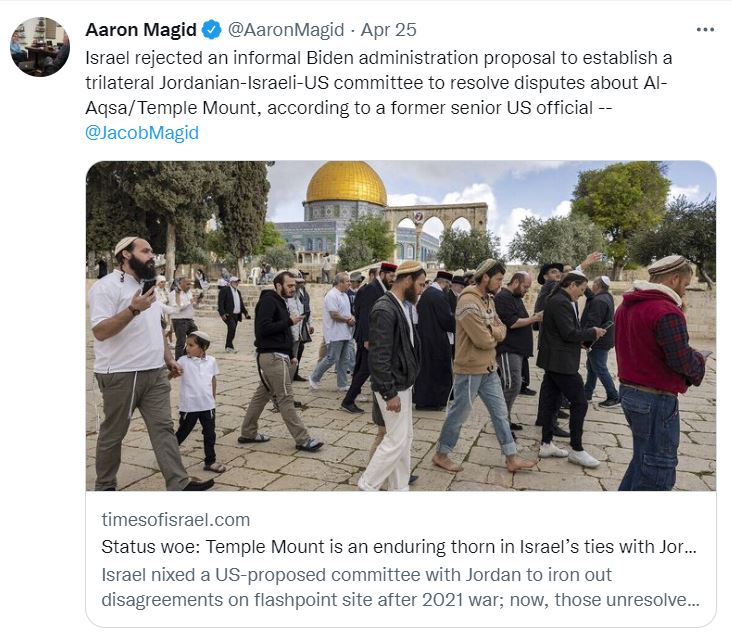
“The events unfolding this month are another manifestation of chronic challenges to the Status Quo. Since 2003, entrance of Jews to the Holy Esplanade has been uncoordinated with the Waqf and therefore considered by them as an 'incursion.' In addition, dynamics on the Israeli right propelled Jewish prayer to the fore...This issue, together with other factors that threaten stability, has been partially addressed by the current government. Nonetheless, even its best efforts were insufficient, as Muslim youth perceived the site to be unprotected by a Muslim actor with real agency and mobilized – more organically than organized by Hamas or by other groups – to engage in clashes with Israeli authorities,” explains Dan Rothem, Project Director at Tachlith.
Amid a particularly sensitive holiday period, the status quo at Jerusalem’s holy sites was seriously tested. On the surface, Israel demonstrated adherence to the status quo – but there is no doubt that there has been a steady deterioration over previous years. Israeli religious and nationalist trends have steadily chipped away at the status quo, with access to Jerusalem’s holy sites having become an issue of asserting sovereignty. Acompanied by a zero-sum and exclusionary narrative, this is detrimental to the prospects for reaching a wider political solution to the conflict. The TSI’s relevant Holy Sites and Solvability of Core Issues – Jerusalem parameters remain unchanged this month at 6 and 5 respectively.
|
|
|
|
Hamas Capitalizes on Jerusalem Clashes to Inflate Its Standing, Weakening and Isolating Palestinian Authority:
A number of rockets were fired towards Israel by Palestinian factions from the Gaza Strip and Lebanon in response to unrest on Temple Mount/Haram al-Sharif this month, sparking concern that the sides are teetering on the brink of a new war. But while events in Jerusalem have emboldened Hamas, which has capitalized on the direct connection it has drawn between Jerusalem and Gaza to inflate its diplomatic leverage, both sides demonstrated a clear interest in avoiding an escalation.
Israel carried out limited air strikes in response to rocket fire from Gaza on April 20th, but refrained from responding militarily after additional rockets were launched less than 48 hour later. Instead, Defense Minister Benny Gantz announced a two-day closure of the Erez pedestrian crossing – blocking about 12,000 Gazan workers from entering Israel.
Hamas, at least outwardly, took a harsh tone with rival factions in the Strip, arresting dozens of Islamic Jihad activists while also sending messages to both Egypt and Israel that it is not interested in an escalation. At the same time, Hamas has actively sought to capitalize on unrest in Jerusalem to galvanize support in Jerusalem and the West Bank and inflate its standing while undermining the authority of both the PA and Jordan.
|
|
|
|
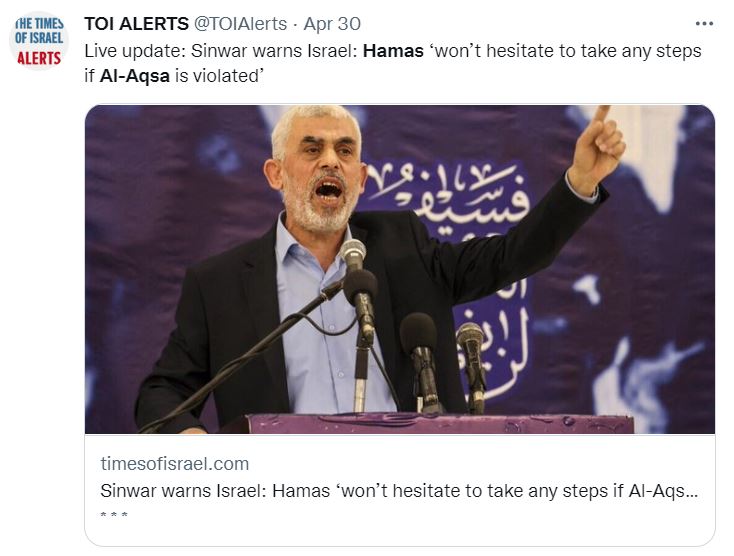
Qatari and Egyptian interlocutors, including the Egyptian president’s son Mahmoud al-Sissi, have increasingly side-stepped Abbas and the PA to hold direct talks with Hamas leader Ismail Haniyeh on ways of averting an all-out confrontation with Israel. Haniyeh was in direct contact this month with senior Egyptian intelligence officials, Qatari ruler Sheikh Tamim bin Hamad al-Thani and his foreign minister, Arab League Secretary-General Ahmed Aboul Gheit, Oman’s Foreign Minister Sayyid Badr Albusaidi, and UN Special Coordinator for the Middle East Peace Process Tor Wennesland.
“The crisis in Jerusalem has given more credit to Hamas both in the eyes of the Palestinian people and the international community. Hamas has become the new center for diplomacy, while the PA has become more and more paralyzed and isolated. Hamas has emerged as the only party capable of making war and peace with Israel, as the ‘new voice’ of the Palestinian resistance, and that is what resonates with the Palestinian streets,” analyst Mohammed Daragmah says.
Hamas’ popularity and influence on the trajectory of events across the Palestinian Territories has led to a shift in Israel’s deterrence strategy. Until now, Israeli has largely differentiated between the West Bank and Gaza Strip fronts. But changing realities requires a more dynamic and “preventative” approach, taken alongside measures to strengthen the eroding authority of the PA. The TSI’s reverse-scale Prospects for War parameter drops from 4 to 3.5 this month, as both Hamas and Israel show restraint in the face of a major test of their commitment to a relative calm that has prevailed for almost a year. The reverse-scale Governance (Gaza) parameter, meanwhile, rises from 3 to 4 this month reflecting effective governance in the Gaza Strip.
|
|
|
|
Amid Sharp Rise in Violence, Coalition Crisis Likely to See Acquiescence to Demands on Illegal Outposts:
|
|
|
|
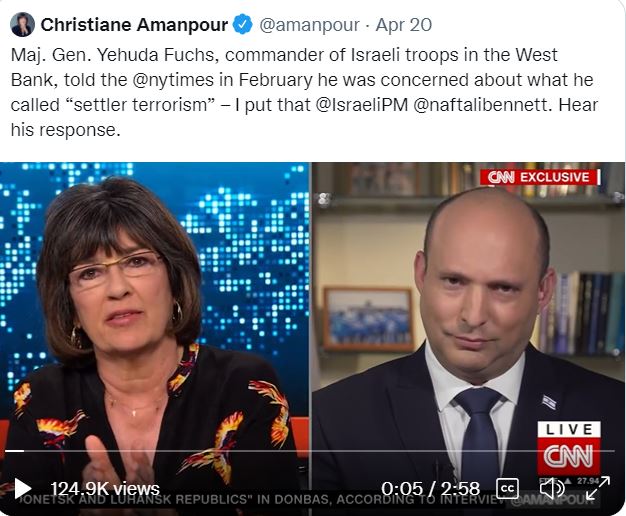
The loss of the coalition’s razor-thin majority this month could see the Israeli government acquiesce to some key settler demands in order to avoid defections among right-wing lawmakers who have predicated their participation in the faltering coalition on issues such as the legalization of the Evyatar outpost . Meanwhile, a Justice Ministry opinion this month stating that illegal West Bank communities can be hooked up to the electricity grid under specific criteria and limitations may lead to a process that will end in approving power for both a handful of illegal Israeli outposts as well as 10-15 Palestinian villages in Area C.
Ongoing settler attacks and the continuing non-intervention by Israeli sees the TSI’s new reverse-scale Settler Violence parameter hold steady at 8 this month. The reverse-scale Settlement Planningand Settlement Construction parameters rise to 5 and 4 respectively, reflecting current Israeli policies that show restraint in response to settlement issues. The reverse-scale Expropriation of Palestinian lands / Legalization of Settlements parameter falls to 4, however, amid moves paving the way for the legalization and legitimization of a number of illegal Israeli outposts in the West Bank. At the same time, the reverse-scale Jerusalem Settlements parameter rises to 4 after a decision to extend a stay on the evacuation of several Palestinian families from their homes in the flashpoint Sheikh Jarrah neighborhood.
|
|
|
|
The Two-State Index (TSI) is brought to you by the Geneva Initiative, a Palestinian-Israeli organization working to promote a negotiated peace agreement in the spirit of the two-state vision. The TSI is produced by an Israeli-Palestinian team, and reflects a unique bilateral perspective.
|
|
|
|
Think we missed something this month? Send us tips and comments here.
|
|
|
|
|
|
|